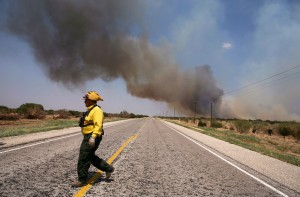Federal Cuts Mean Fewer Resources This Wildfire Season

Photo by Tom Pennington/Getty Images
Lone Camp Volunteer Fire Department chief Charlie Sims leads his crew while fighting a wildfire on September 1, 2011 in Graford, Texas.
First, the good news for Texas.
Most of the state is not expected to be at an “above average” risk for wildfires this summer, according to the National Interagency Fire Center. The reason for that might depress you: in parts of the state with less vegetation, like West Texas, years of drought and fire mean there’s little left to burn.
“That was part of the reason why some of the fire activity this past winter spring was down from last year,” Tom Spencer head of predictive services with the Texas Forest Service, tells StateImpact Texas.
Spencer said wooded parts of the state like the Hill Country and the Piney Woods are at greater risk of fire.
“As we get towards the end of the summer as that drought starts to kick in, just be aware that it could happen,” he warned.
And no matter how many fires break out, officials said Monday they’ll have less resources to work with.
Speaking in a telephone news conference, secretaries for the departments of Interior and Agriculture enumerated the ways the so-called “sequestration” has hit their departments.
“As a result of across the board cuts that have been applied, we’ll have about 500 fewer firefighters at the Forest Service than we might otherwise have,” said Secretary of Agriculture Tom Vilsack, “that might impact about 50 engines that we might otherwise have.”
Secretary of the Interior Sally Jewell said cuts were coming primarily from programs that aim to reduce the chance of fire, and from other projects that repair fire-damaged land.
“One of the consequences in taking resources and focusing them on suppression with limited resources is, you can’t do as much of the advanced work as you would like, or the post-fire remediation that you would like,” she said.
Spencer of the Texas Forest Service said he was also concerned with the impacts of federal cuts.
“At the national level, out in the western part of the U.S., where they’re expecting some fires this summer, that would certainly mean that there would be less federal resources that could be available to assist the state of Texas should a fire season develop here,” he said.
Currently analysts predict the most fires to break out along the West Coast and into the mountainous regions of Idaho and Montana. They are positioning firefighting resources in those area for rapid response in the event of fires.

